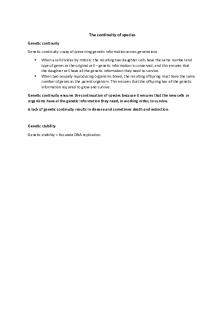Outline and Evaluate the Effects of Endogenous Pacemakers and Exogenous Zeitgebers on the Sleep Wake Cycle PDF

| Title | Outline and Evaluate the Effects of Endogenous Pacemakers and Exogenous Zeitgebers on the Sleep Wake Cycle |
|---|---|
| Course | Clinical Psychology |
| Institution | De Montfort University |
| Pages | 1 |
| File Size | 48.4 KB |
| File Type | |
| Total Downloads | 17 |
| Total Views | 126 |
Summary
essay based on pacemakers and sleep wake cycle...
Description
Outline and Evaluate the Effects of Endogenous Pacemakers and Exogenous Zeitgebers on the Sleep/Wake Cycle The main endogenous pacemaker in mammals is the suprachiasmatic nucleus, a bundle of nerve cells in the hypothalamus. It is located just above the optic chiasm, and receives information about light when our eyes are open, and shut. Photoreceptors the eye transfer light signals to the SCN, shifting our endogenous clock to meet the demands of the world outside. Our clock is also affected by the pineal gland which releases melatonin. This sits just behind the hypothalamus, and is passed information about light, via the SCN. When it is light, the pineal gland inhibits the release of melatonin, making you feel more awake. At night, melatonin is released, making you feel tired. The role of the SCN in the sleep/wake cycle can be demonstrate with animals, through lesion studies and cellular implantation. DeCoursey destroyed the SCN connections in chipmunks and returned them to their natural habitat for 8 days. She found that many of them we killed by predators, in a short space of time, as they left their nests during the wrong part of the day. This suggests their rhythms had been altered showing the role of the SCN in the sleep/wake cycle. Furthermore, it is shown by Ralph who implanted SCN cells from mutant hamsters, into regular hamsters. These mutant hamsters had a sleep/wake cycle of 20 hours. He found that those with the implant had altered their circadian rhythm to that of the mutants, thus supporting the role of the SCN. Both of these studies used strictly controlled conditions, allowing high reliability. Despite this, there are issues with generalisations, as animals were used. Humans may have more complex social cues, which alter the sleep/wake cycle. Moreover, they could be considered unethical; as the animals were exposed to harm and the results may not justify the harm. This implies a cost benefit analysis was needed, as there are questions around whether the research has substantial benefits compared to the ethical drawbacks. There are also external factors which reset our biological clocks through entrainment. These are called exogenous Zeitgebers. A key zeitgeber in humans is light. It can reset the SCN, changing our sleep/wake cycle. It also has an indirect influence on bodily functions, such as hormone secretion and blood circulation. Another zeitgeber is social cues. This is shown by babies, who do not have the same sleep/wake cycle as us. Theirs is random. They are not entrained until they are at least 6 weeks of age, and the bedtimes and mealtimes, exerted by parents are key Zeitgebers in this process. This knowledge has practical application; understanding the role of exogenous Zeitgebers have on our sleep, can decrease the impact jetlag has on our bodies. Burgess found that exposure to bright light can decrease the amount of time needed to readjust to local times upon arrival. She used three groups of participants, exposing them to different levels of light. They found that the light allowed the participants to shift their circadian rhythms by up to 2 hours. This suggests we can entrain our biological rhythms, and reduce the impact of jetlag. Furthermore, it can be useful to those who often take long haul flights, as they can improve their productivity and concentration. In addition, there may have been exaggeration on exogenous zeitgebers, as some individual’s pacemakers are built to withstand the influence of environmental cues. A case study of a blind man, who had a circadian rhythms of 24.9 hours showed that his sleep/wake cycle could not be adjusted by social cues, thus he required medication in order for him to sleep and wake up every day at the right times. Furthermore, much of the research on endogenous pacemakers and exogenous zeitgebers are case studies, or use a small sample. Consequently, it is impossible to generalise the findings to whole populations, as there may be individual differences which cause some individual’s to behave abnormally. Thus, this suggests that the results cannot be generalized as other factors such as age and gender may have significant impacts on circadian rhythms....
Similar Free PDFs

Ch 8 Eating and Sleep-Wake Disorders
- 11 Pages
Popular Institutions
- Tinajero National High School - Annex
- Politeknik Caltex Riau
- Yokohama City University
- SGT University
- University of Al-Qadisiyah
- Divine Word College of Vigan
- Techniek College Rotterdam
- Universidade de Santiago
- Universiti Teknologi MARA Cawangan Johor Kampus Pasir Gudang
- Poltekkes Kemenkes Yogyakarta
- Baguio City National High School
- Colegio san marcos
- preparatoria uno
- Centro de Bachillerato Tecnológico Industrial y de Servicios No. 107
- Dalian Maritime University
- Quang Trung Secondary School
- Colegio Tecnológico en Informática
- Corporación Regional de Educación Superior
- Grupo CEDVA
- Dar Al Uloom University
- Centro de Estudios Preuniversitarios de la Universidad Nacional de Ingeniería
- 上智大学
- Aakash International School, Nuna Majara
- San Felipe Neri Catholic School
- Kang Chiao International School - New Taipei City
- Misamis Occidental National High School
- Institución Educativa Escuela Normal Juan Ladrilleros
- Kolehiyo ng Pantukan
- Batanes State College
- Instituto Continental
- Sekolah Menengah Kejuruan Kesehatan Kaltara (Tarakan)
- Colegio de La Inmaculada Concepcion - Cebu














